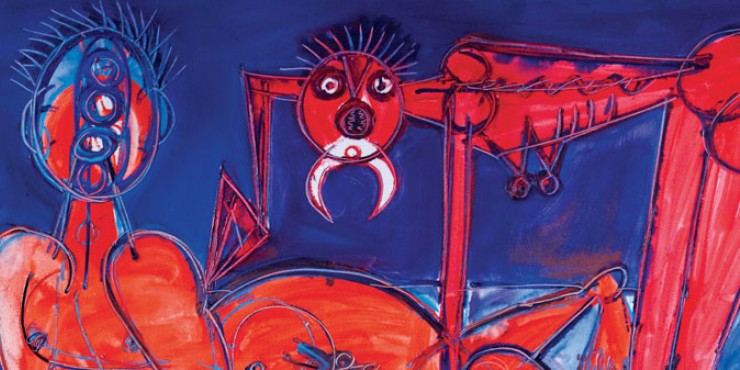
Since his appearance on the art scene in the mid-1960s, Jiří Načeradský has been considered a highly creative artist ranking among the greatest figures of Czech art of the second half of the twentieth century. One of the artist’s recent exhibitions, Beautiful Sex Machines, indicates the fundamental nature of his work. What important milestones on the road leading from Načeradský’s famous “Runners” (1967), the peak of new figuration (not only) in Czech art, have led up to the current development?
During the period of diverse forms of abstract art surviving in our art, particularly Art Informel, Načeradský was able to discover new art forms and to shift the boundaries towards emerging new sensibility as its co-creator. A return to reality, to the perception of life brought about radical changes in the use of a non-traditional painting process. He was one of the first artists to explore and use the principle of appropriation to paraphrase the works of old masters and modernists, and make use of photography and a wide range of expressive and distorted forms rendered with a touch of parody and the grotesque. In his own words he has been a postmodernist since his youth. However, he delved deeply into traditions of European as well as Czech modern art and the Czech grotesque up to reminiscences of Čapek’s geometric art. Respect for tradition and an unconventional approach to it allowed Načeradský to achieve an entirely new conception of painting.
Although drawing does not necessarily have to be the preparation for a picture, it has become a way of thinking, of perceiving and interpreting the world. The artist’s exceptional skill at drawing gave his work a lasting imprint. The linear principle became the core of his paintings. In many of his series from the 1970s, he used his skill in a new way. They are dominated by Kafkaesque and machinist figures of insects, symbols of womanhood and praying mantises. The prevailing erotic tone embraces the principle of the origin of life.
During six decades, Načeradský’s work has become a rich source of art forms, reflecting variations and transformations reminiscent of living matter. Even now he changes his style, but it is still Načeradský’s identifiable idiom that has remained faithful to its nature. He is brimming with new ideas, shapes, forms, with compositions of drawings, shapes and colours. Sometimes it may seem that the artist has been completely lost in the maze of forms and shapes, but the opposite is true: for him a way out of it is always perfectly clear. The iconic motif of the praying mantis suggests the idea of a committed artist; even though he is fascinated by art, he keeps its laws under control.
The exhibition is a selection from the collection of the Slovak art collector Ivan Melicherčík.
















